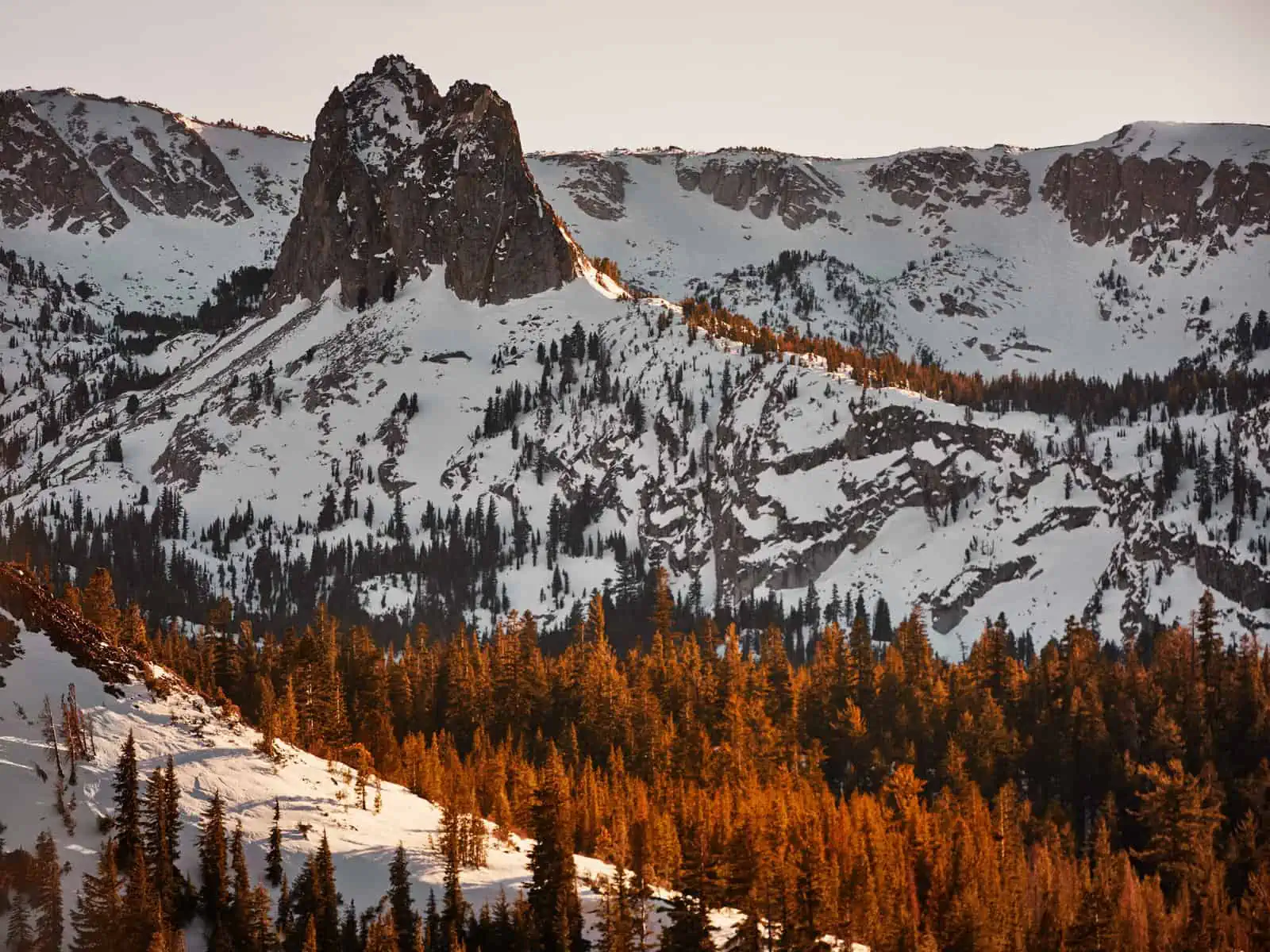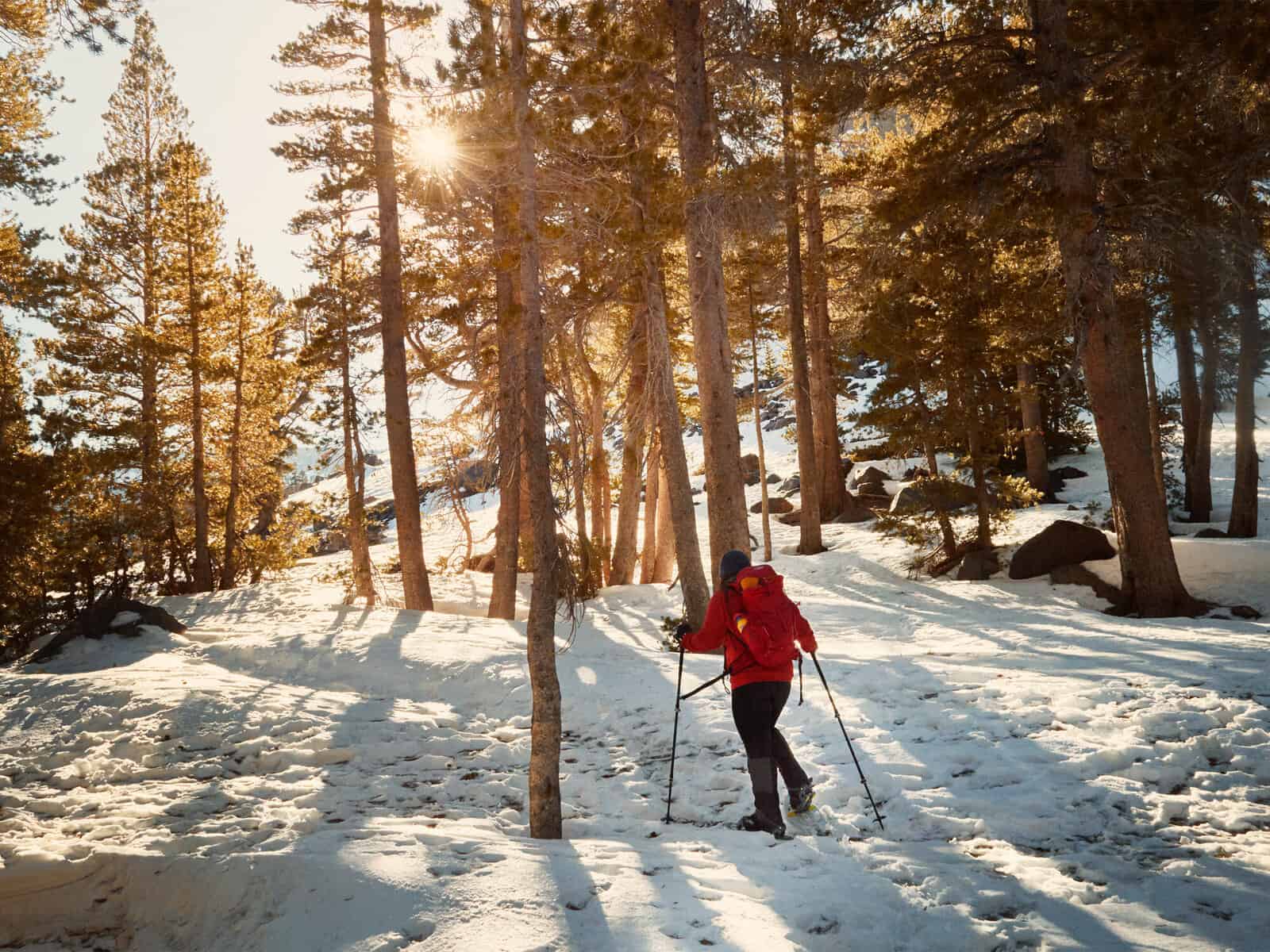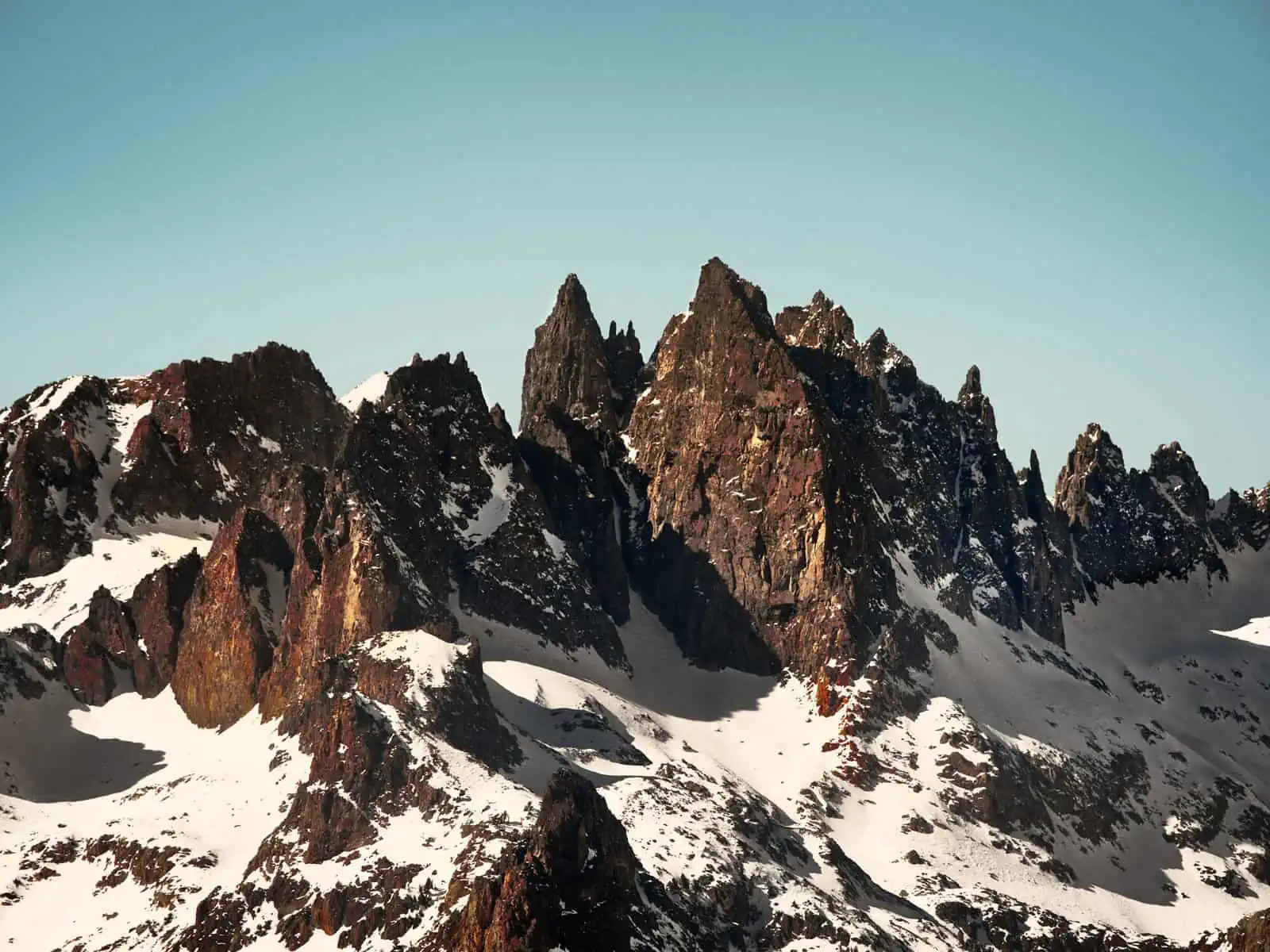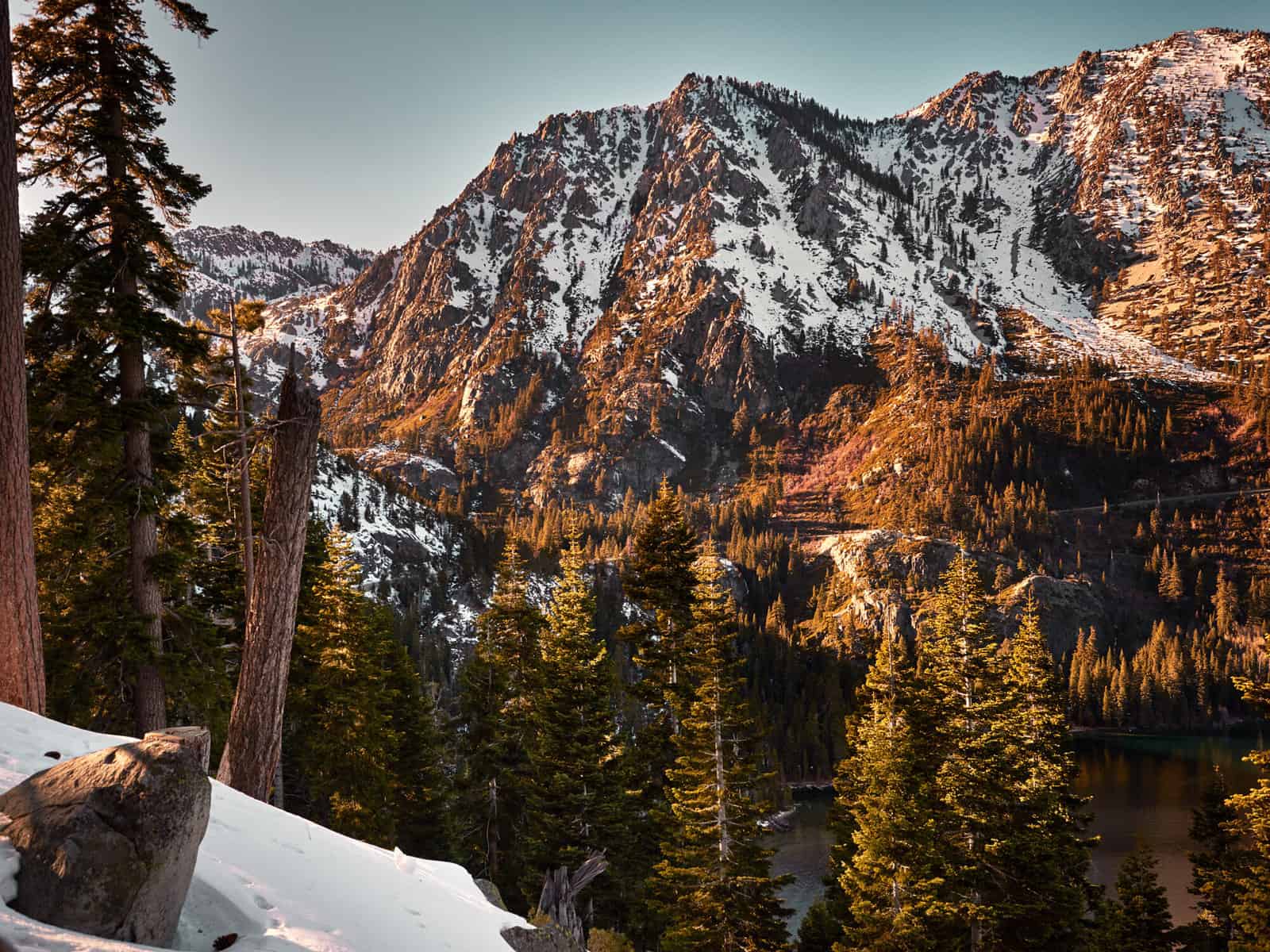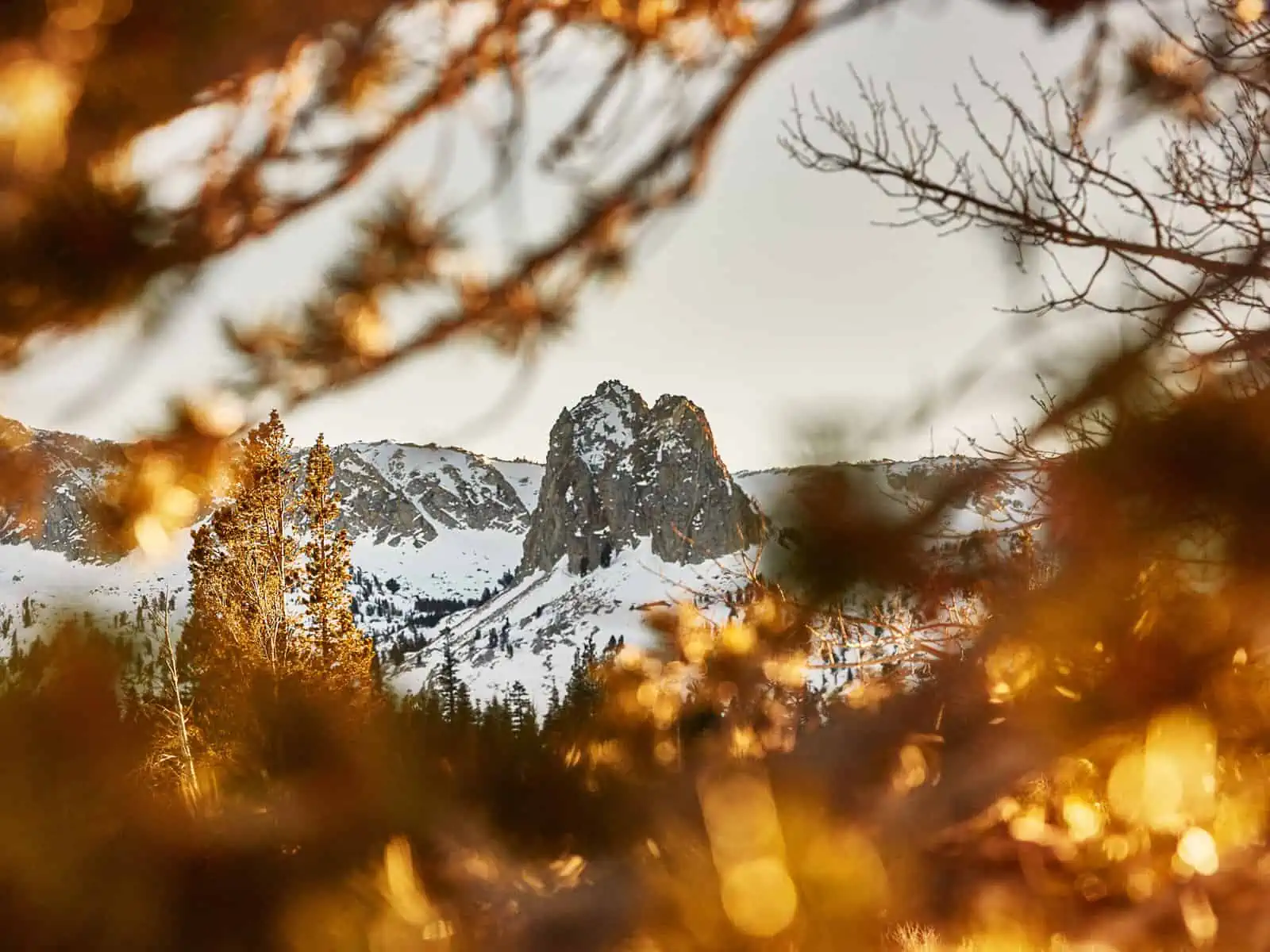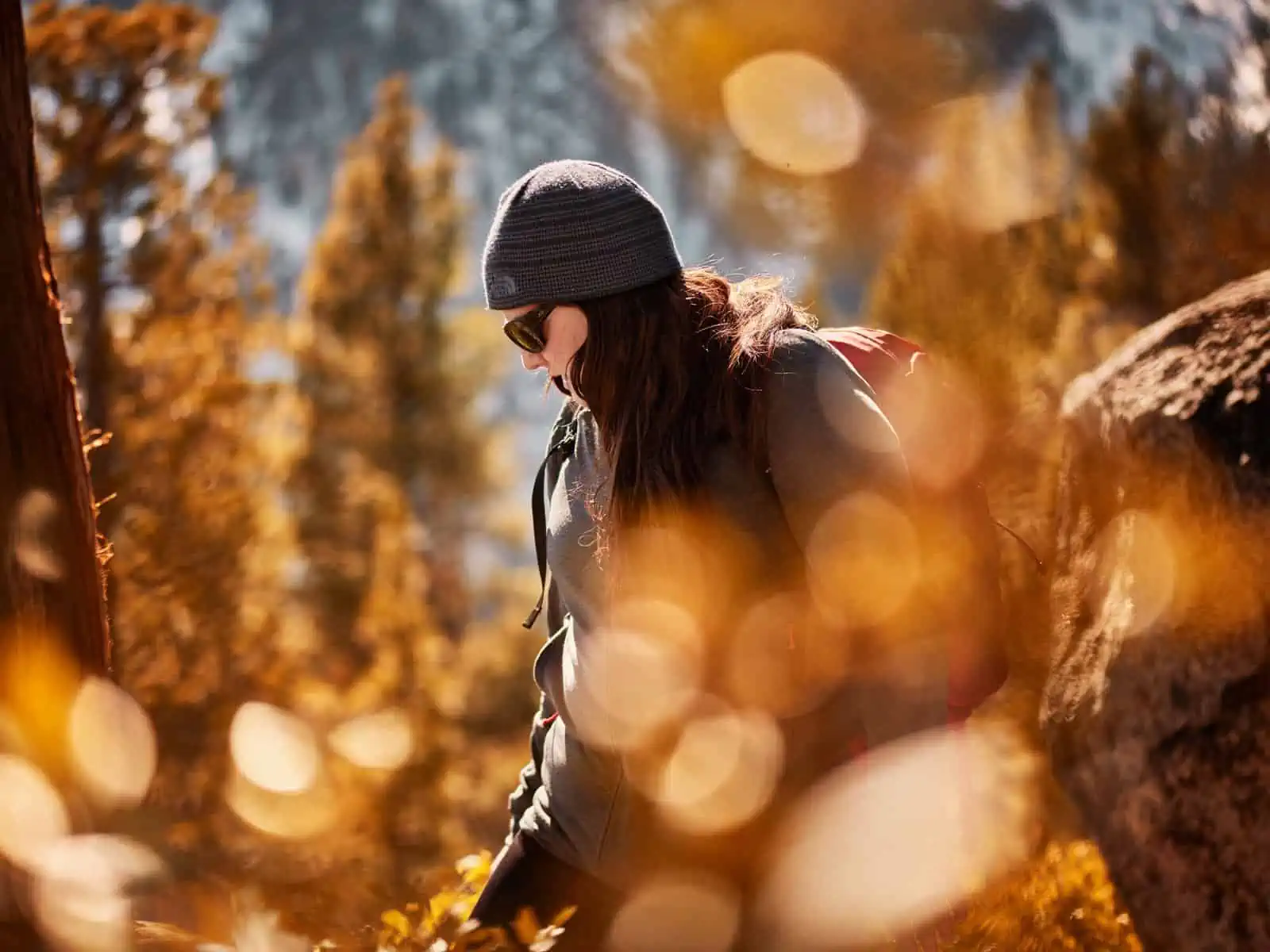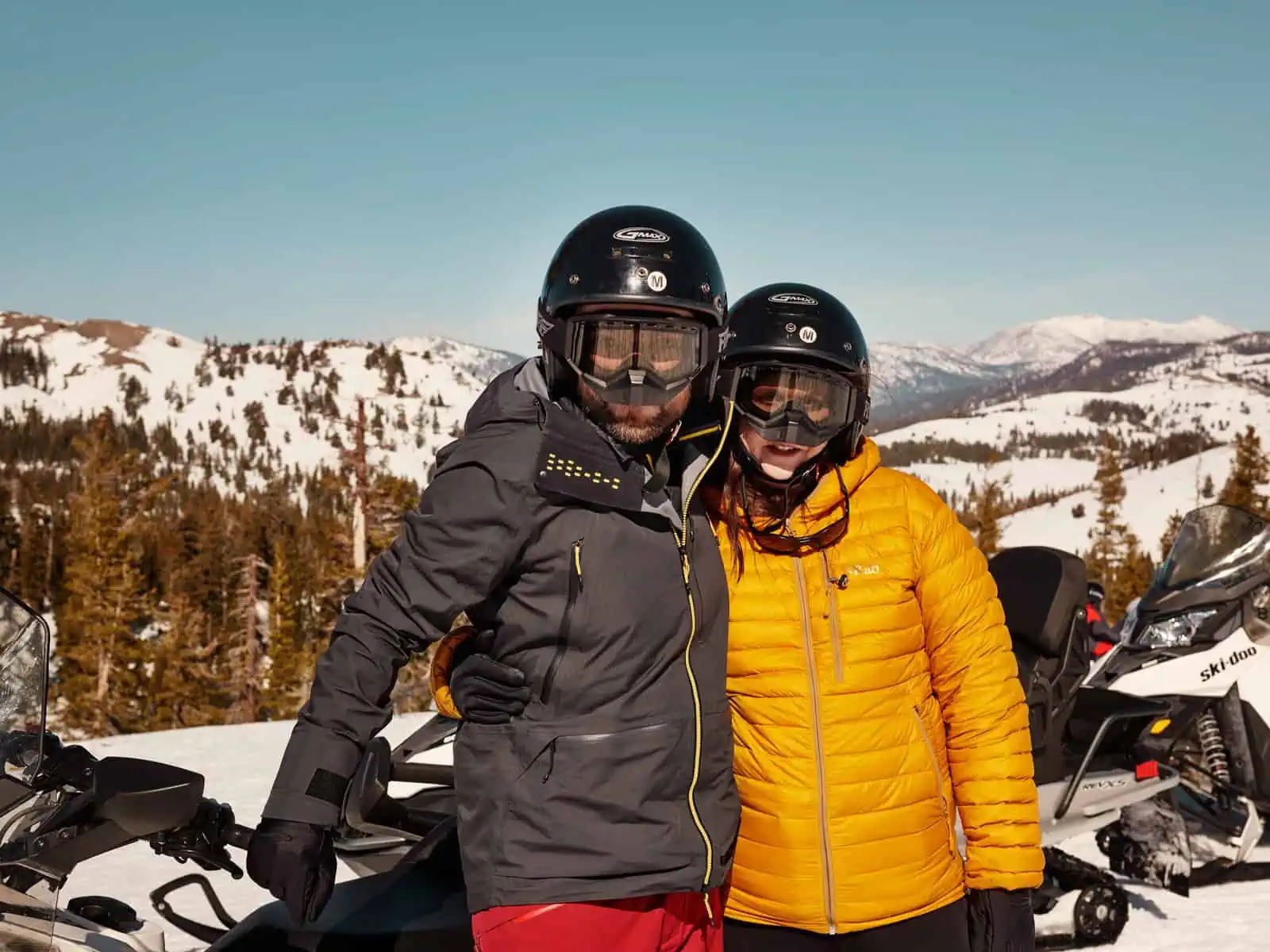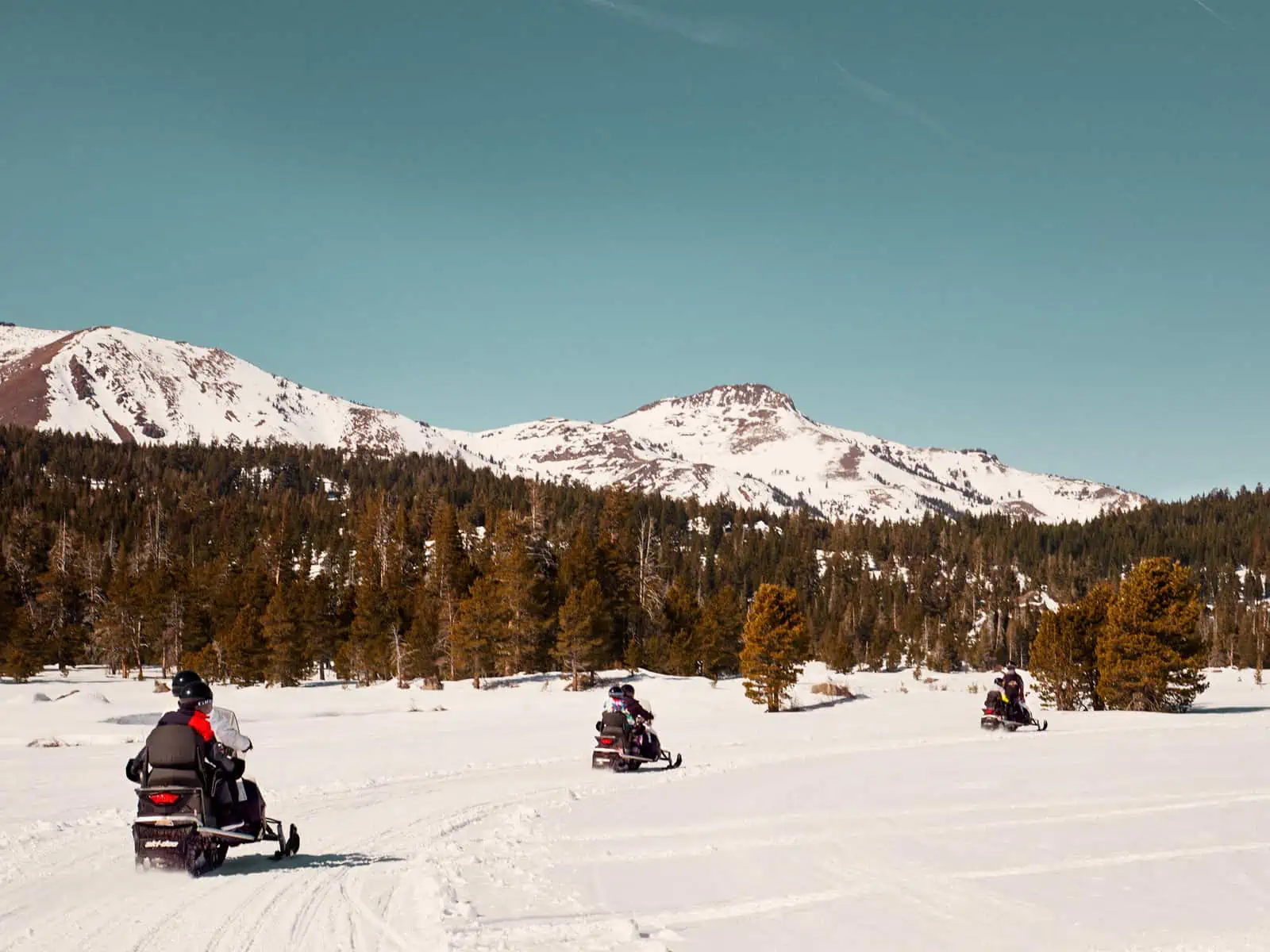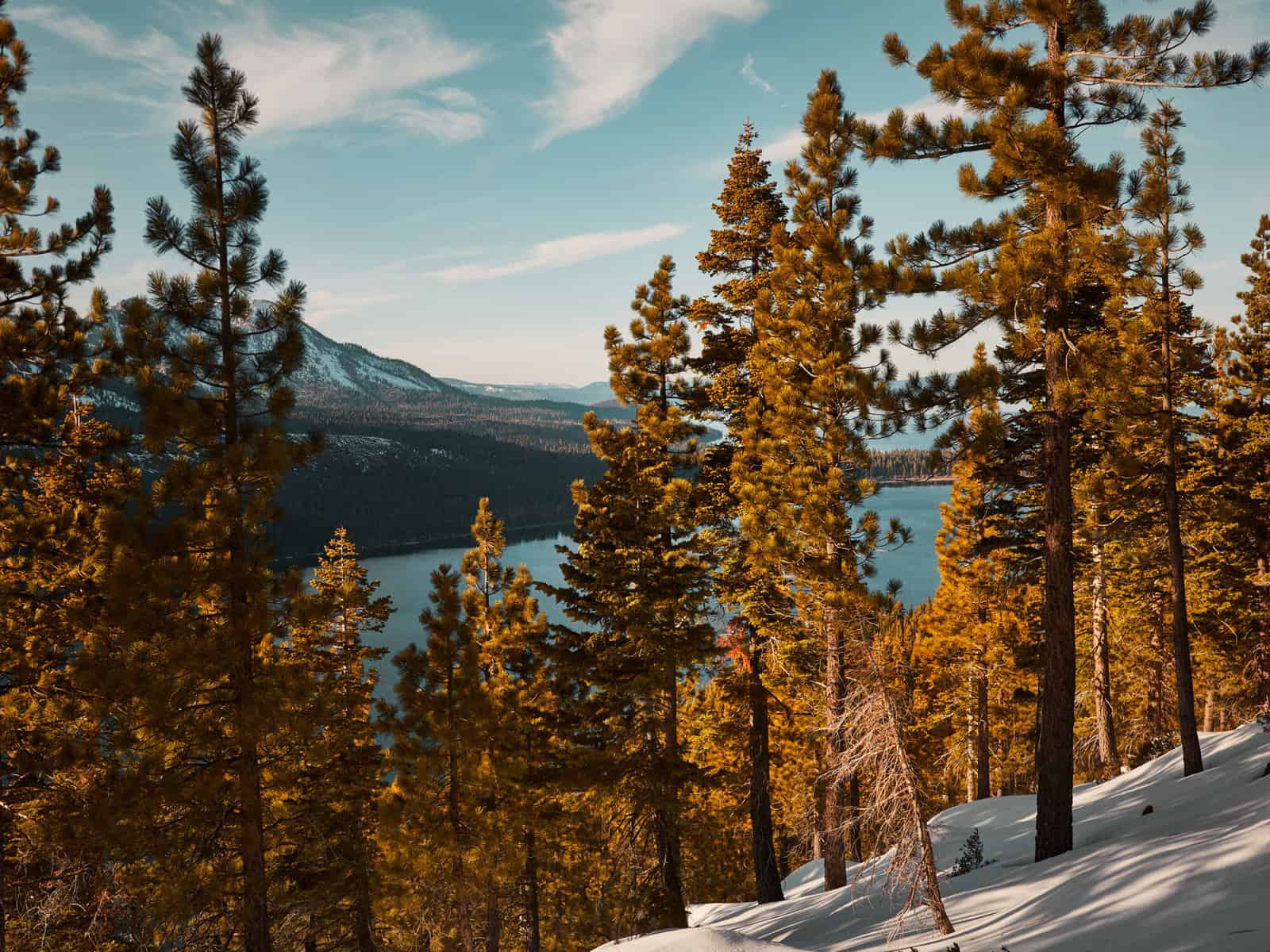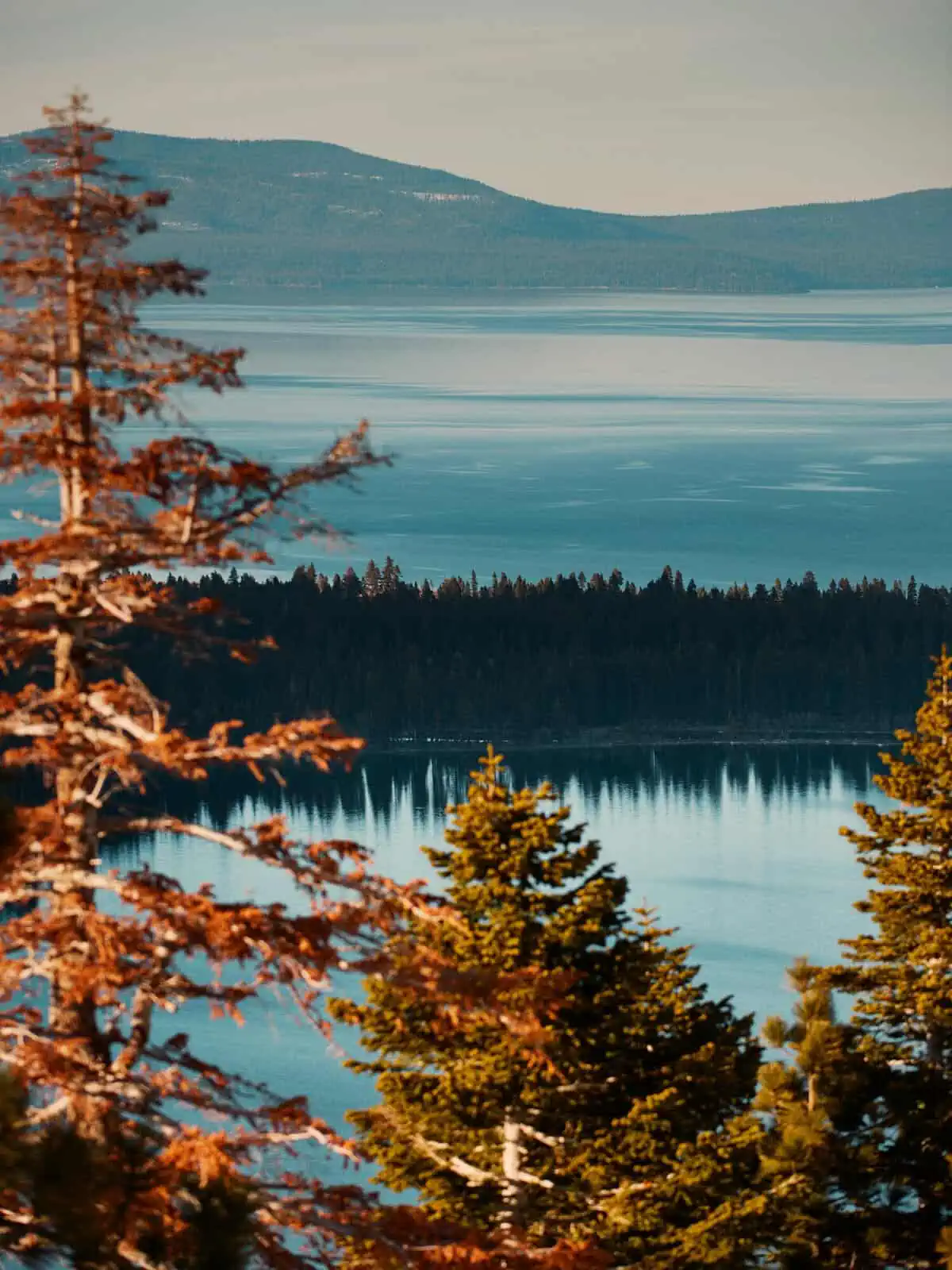This article is sponsored by Visit California and Enterprise. All opinions are our own.
Our last trip to California in October 2019 saw us exploring the Sierra Nevada – a vast range of mountains that begins just a few hours’ drive north of Los Angeles.It’s safe to say that visit blew us away.At once, the Sierra Nevada Mountains reminded us of the Alps and Pyrenees in Europe that we were already well familiar with, but at the same time, the mountains presented us with something new – the wilderness was on a completely different scale to what we were used to in Europe, and the sheer potential for exploration and adventure simply amazed us.That last trip had taken place right at the end of summer and whilst we were there, we experienced the first dusting of snow fall on some of our hikes.
When we started to see the snow, we admittedly felt a little out of our comfort zones; snow presents a whole new set of ideas! Whilst we were out on the trails on our October 2019 trip, the start of the snow caused contention for a lot of people we spoke to who classed themselves as ‘just summer hikers’. The smatterings of snow we saw and start of ice were enough to put some of the people we spoke to off their hikes. It seems true, especially from various hikers who were members of online hiking groups, that many people’s outdoor adventures are kept solely for when the weather is nicer and there is no chance of snow on the ground (which is often referred to as hiking season). The problem here though is this can limit your hiking to just a couple of months a year. If you don’t ski, snowboard etc., it can really limit where you go on vacation . It can really stop you from being able to see a lot of what the world has to offer. But the thing is, snow can make mountains seem like a completely inaccessible place. We hear talk of avalanches, we think of the cold, and we think of a landscape that is highly unknown to us. It can feel really daunting. You immediately think of people who seem to have been enjoying the snow since birth and you start to see a separation. It isn’t surprising that many people we’ve spoken to, ourselves included, have felt like the winter landscape is completely inaccessible to them.
We remember the first time we had real access to a snowy landscape; it was about two years ago now and we decided to take a winter trip to the Alps. Buzzing past us on skis, everybody looked so calm and confident like they had everything figured out! We didn’t have a clue what we were doing, but we knew we wanted to explore. We could see this incredible landscape around us but had no idea how to get further into it. Then we saw some people travelling by snowshoe. At first, we were intrigued and had absolutely no idea what they were, and then it clicked. We saw more and more people exploring by snowshoe and decided to give this way of exploring the snow a try.
It has really only been in the last year that we have started to see just how much the winter landscape can open up to us and how we can travel through it without needing many years of experience, but instead, some common sense skills and a desire to explore and be open.
We didn’t want the snow to be something that limited our desire to explore any more than it really needed to, and based on the conversations we’ve had with many of you about what it is that stops you from getting out into the winter landscape, we were able to boil this down into a couple of key points:
- Fear of failure
- Lack of confidence / skills / knowledge
- Fear of the unknown
We think that many people are put off from hiking and exploring in deep snow because they think they need special skills along with expensive equipment. Mention deep snow and most people will automatically think of skiing. Skiing is perceived as an expensive hobby that can lead to serious injury if you don’t know what you are doing.By contrast, snowshoeing is often ignored – we think most people don’t even know it exists – and indeed in the UK, we found that in outdoor stores that specialise in ski gear, the staff would often not even know what we were talking about when we mentioned it!This is an enormous shame, because in our opinion, it’s a great way to make the winter landscape accessible.
Many people who do know about snowshoeing will think of early twentieth century polar explorers with things that look like wooden tennis racquets attached to their feet.The equipment has developed a lot since then – ours are high-tech polycarbonate frames with integrated crampons for extra grip.Nonetheless, the principle is still the same: you attach something to your foot to give you a larger contact area with the snow.This spreads your weight and stops you from sinking in.
Snowshoeing has several key advantages to skiing: first of all, it does not require any special skill. If you can walk, then you can snowshoe!Really, it’s that simple.You could put on a pair of snowshoes having never worn them before and be ready to hit the trail within a minute or two. You just need to be careful not to cross your feet too much whilst walking as you can trip yourself up. The first time we wore snowshoes, we tripped (but didn’t fall) when we tried to turn on the spot. That hasn’t happened since!As you are just walking, rather than travelling at speed, you don’t need any of the other essential gear associated with skiing: a helmet, rigid boots etc. That said, a pair of walking poles are very useful when snowshoeing and ski goggles can be handy if you are heading out in very harsh weather.
All of this leads to the next big advantage over skiing: Snowshoeing is much cheaper! Our snowshoes are far from basic entry level models and still cost well under £100/$130. It’s true that you can spend a lot more on larger expedition grade snowshoes, but these are overkill for the kind of hiking we’ll be talking about in this article. Snowshoes can also be hired very inexpensively from the same places that rent skis at major resorts. On a similar note, access to every snowshoe route we mention below is free.
The real benefit of snowshoes is seen when you are trying to move over deep snow.The larger contact area stops you from sinking in as much as you would in boots alone and as such, lets you progress more quickly and evenly. On more shallow snow or the compacted surface of a well-trodden trail, this benefit is lost, but all the snowshoes we have seen also have some form of gripping spikes built in. Acting like mountaineer’s crampons, these spikes give you a much surer footing on icy surfaces and we cannot overstate the benefit of this – especially when you have expensive camera gear hanging around your neck! As such, we’ll often keep our snowshoes on for extra grip and so we can maintain a good walking pace even when moving through shallow or compacted snow.
Enjoyed reading? You might also enjoy our piece on hiking near Denver
As you are out in winter, you’ll need warm clothing. This is quite a personal choice, so it’s worth seeing what works for you. We prefer to wear many layers. For the top, typically one or two layers of Merino wool or synthetic technical fabric with a down coat (either synthetic or real) over that for warmth, followed by a hard shell to block heavy wind and any moisture from snow or rain. On the bottom, Fay wears two layers of thermal leggings with an optional insulated and/or hard shell layer if it is exceptionally cold, windy or snowing heavily. Matt prefers Merino wool leggings as a base layer with insulated ski trousers over the top. We both wear a double layer of socks and winter hiking boots on our feet (as photographers, we spend a lot of time standing still whilst shooting, so we find we need more heavily insulated boots than a more active hiker might).On top of this, gloves, a hat and dark sunglasses to combat the glare from the snow are also essential. Little of the clothing we wear for deep winter exploring is used exclusively at that time of year and it mostly just comes from our regular wardrobe of hiking gear – we just find we layer up more for winter.
Now, with all of this, we are not saying that snowshoeing is better than skiing.We are just saying it is different.Even if you are a committed skier, we think it’s worth giving snowshoeing a shot: It’s easy, inexpensive and you get to experience the landscape at a gentler pace.
All in all, we think the skill and equipment threshold for exploring the deep winter landscape is far less than most people think.For sure, it is relatively easy to get into a lot of trouble if you set out into the snow unprepared, but by the same token this does not have to be in the realm of fearless adventures either and the key to this is having the right places to explore.
When we started working on this project, Visit California suggested that two great locations for us to start developing our confidence with exploring the winter landscape were Mammoth Lakes and South Lake Tahoe in the heart of the Sierra Nevada, California. The Sierra Nevada Mountains runapproximately 400 miles (640km) South to North through California roughly parallel with the Pacific coast.The Sierra Nevadais a vast mountain range – starting just North of Los Angeles and carrying on well past San Francisco.Plenty of this vast wilderness are designated as National Parks and Forests – Yosemite being the most widely known National Park in the range.The Sierra Nevada isalso home to Mt. Whitney – the tallest peak in the ‘Lower 48’ states at 14,505 ft (4,421m).
We have always accessed the Sierra Nevada from Los Angeles and it’s only a few hours’ drive from Downtown LA through the desert before you reach Owens Valley and the start of the Sierra Nevada Mountains. Looking at a map, it might seem like the mountains are just as accessible from San Francisco and, whilst the absolute distance is similar to travelling from LA, it’s worth noting that starting from San Francisco requires you to physically cross the mountains. This means travelling on steep winding passes that do get closed down in winter – indeed, on our visit, every major pass that crossed the mountains we encountered was closed due to snow – so, coming in from San Francisco could well involve a lengthy detour to reach the destinations we visited if coming in winter. In summer, of course, it’s a different matter, but this is a factor you should absolutely be aware of if planning a visit.
Whilst planning our trip we were advised by Visit California and Visit Mammoth that we would need to hire either an AWD or 4WD vehicle.Heavy snowfall is a reality in this part of the world in winter and, whilst many roads are ploughed, there’s always the very real chance that you may find yourself driving on icy or snow-covered roads.As we got deeper into the mountains, we saw signs advising that an AWD vehicle with four season tires was necessary as a minimum. The signs also advised that we carry snow chains.
As usual, the helpful and knowledgeable staff at Enterprise saw us on our way with an appropriate vehicle, and we chose a large SUV with automatic 4WD control. It was a perfect choice for this trip; we felt very safe on the roads, and it had the right level of luxury and driver assist features to make the long distances we covered pass by easily and pleasantly.
So, why does the Sierra Nevada, and particularly Mammoth Lakes and South Lake Tahoe make for great stomping grounds to develop your confidence in the snow? For us, it comes down to a number of things that can have a massive impact on your confidence and help you enjoy the trip more, meaning that you’ll likely have a better experience and want to get out on the snow again. Something we’ve noticed when you’re pushing yourself out of your comfort zone is that self-care is really important and giving yourself little luxuries go a long way to boosting your confidence in a supportive environment even further. Firstly, there is the weather! Of course, in mountain areas weather can change quickly, but when we visited in February, we only had one day of bad weather on our entire trip. For the rest of the days, we had gorgeous blue skies and manageable temperatures. Waking up to a blue sky most days really does a lot for wanting to get outside and explore! There is no doubting that the sun just makes you feel better. There is also the fact that both Mammoth Lakes and South Lake Tahoe are set up as resort towns, so it is very possible to get out on the snow in the day and go to a spa, restaurant, cinema (really, you name it) afterwards. In terms of the trails, everything is signed in English. This might not seem like such a big thing, but we’ve found that removing as many ‘what if’ elements as possible has a huge effect on building confidence. Knowing you’re going to understand everything makes a huge difference and leaves no real room for ‘lost in translation’ situations. This also helps in visitor or information centres, and everybody we spoke to couldn’t go far enough out of their way to help us – something that really put us at ease. There is also the fact that there is access to a huge number of incredibly well-maintained trails and the incredible scenery they offer.
Mammoth Lakes
So, it was time for us to head out into the winter landscape and start developing our confidence in the snow and so, the first stop of our trip was Mammoth Lakes. The drive from LA took us around five hours (just over 300 miles/480 km). This drive is spectacular!You start off crossing open desert before the Sierra Nevada Mountains and White Mountains appear on the horizon. As you follow the 395 Highway North, the desert gives way to a more Alpine landscape and you start to see snow on higher peaks. You’ll also start to see the distinctive Mammoth Lakes logo on road-signs and car bumper stickers as you draw closer. By the time we reached the turn off for Mammoth, we were well above the snow line and we started to feel excited to explore.
Mammoth itself is a fairly compact town, but nonetheless it has plenty of amenities; there’s no shortage of good cafés, bars and restaurants (offering everything from take away pizza to fine dining) along with a couple of large supermarkets if you would rather self-cater.There are – of course – plenty of outdoor stores in case you have forgotten anything or need to hire any equipment. We stayed in a beautiful self-catered apartment at the Snowcreek Resort a few minutes’ drive from the town centre where we felt right at home from the moment we checked in – leaving us feeling at ease for our days of exploring the mountains.
It’s worth noting that Mammoth is at an altitude of 7900 ft/ 2402m – high enough that you will be aware of the thinner air. We’ve written several articles on hiking at altitude and these are well worth reading if you are not sure what to expect.
The main ski areas and trailheads for snowshoeing are all located outside the town and whilst you can drive to all of these, there’s also a network of regular shuttle busses servicing these places. The buses are worth bearing in mind as parking can be difficult at busy times.
Our first port of call was to join the skiers and snow boarders on the cable car up from the Main Ski Lodge to the summit of Mammoth Mountain. Whilst there’s no snowshoeing routes that begin from the summit, it does give spectacular views out over the surrounding mountains and in particular over the Minarets – an almost fairy-tale cluster of jagged peaks. We found that the gondola ride was a great way to ease us into the winter landscape – and it is pretty hard not to appreciate the beauty you see on both your way up, way down and at the top. It really allows you to start looking at the landscape from the perspective of the snow. By the time we headed down, we were ready to get our snowshoes on and explore some more of what Mammoth had to offer.
Mammoth Lakes Trail
We had been recommended to explore the area around the Mammoth Lakes Basin – this is a collection of several lakes (all frozen solid when we visited!) surrounded by spectacular walls of rock. The short drive in and out of the Basin from Mammoth is worth taking, even if you have no intention of snowshoeing, the views are jaw-dropping! Parking is available near the Tamarack Ski Centre on Lake Mary Road – this road is not ploughed in winter and is therefore closed to motor vehicles after the parking area. There are a number of snowshoe trails that start from here and it is a great place for your first snowshoeing experience. For starters, there’s a very easy-going trail around the lake shores, which would be achievable for families with young children. We loved this trail and found it a great start to our snowshoeing experience here. We really felt our confidence start to go up on this trail. Something we needed to practise quite a lot was ‘staying in our own lane’. It’s very easy when you’re doing something like this, to start to get little niggling voices pop up in your head telling you that you could be doing something harder. Or feeling slightly rubbish because you see someone else snowshoeing off ahead of you at a much faster pace. The truth is, we all compare what we’re doing with other people – it is really natural, but it is also going to stop you from enjoying the experience that you’ve carved out for yourself. We purposely chose this hike as our first one as we really believe in the idea of starting at the bottom and working your way up – start with something that is well within your grasp, gain some confidence and go for the next thing.
Panorama Dome Loop
Within a couple of days of being in the snow, we found our eagerness to get outside was massively increasing, and especially made easier by the beautiful sunlight and blue skies we woke up to pretty much every day. Starting slow and building up was having a great effect on our confidence and we were ready for a trail that threw in some uphill too. As per our last hike, the Panorama Dome Loop begins and ends at the Tamarack Ski Centre, which also maintains a groomed piste for Nordic skiers that follows Lake Mary Road. You have to pay to use the piste, but a well-trodden trail runs alongside, and this is free to use for walkers, snowshoeing and cross-country skiers. You can simply follow Lake Mary Road, but another trail, branching off to the left quickly presents itself. This trail takes you on a short but steep ascent through deeper, less trodden snow up to the Panorama Dome – a hill that, as the name suggests, offers exceptional views of the surrounding mountains once you emerge from the trees. The mountain panorama is absolutely spectacular but be sure to turn around and look the other way down into the Owens Valley too – here, the snow gives way to desert and that combination of sand leading into snow never ceases to amaze us! This was a great trail! It’s very well signposted with regular route markers. They are not all quite within direct line of sight of each other, but nonetheless, we had no worries that we had ever lost the trail. Critically, this trail also gets you off the beaten path and into deeper snow where the advantages of snowshoeing really become evident. If you’ve ‘dipped your toes’ into the snow on the nearby lakes, this is a great route to dive in deeper! Eventually, the Panorama Dome trail loops back down to the groomed piste and companion trail on Lake Mary Road – which you can then easily follow back to the car park and bus stop or go the other way and explore deeper if you wish.
We did the Panorama Dome trail in the afternoon and finished up as Golden Hour bathed the landscape in the most beautiful light. However, much of the mountain panorama was in shadow and we actually returned to the trailhead the morning we left Mammoth to shoot some more as the morning light gave the place a very different feel.If you are heading out to take photos, we think the morning would be the best time to attempt this trail.
We started to realise just how much confidence we were gaining from being out in the snow. Perhaps a trail that in the past would have had us wondering if we’d be able to complete felt well within our grasp and we came back admittedly tired (snowshoeing does feel like more work than normal hiking) but also happy with our experience. Being mindful is something that we’ve learned can have a real effect on your confidence with hiking in general. Staying present, concentrating on what we were doing and the scenery around us allowed us to really bed into the experience and enjoy it for all it was.
Minaret Vista Trail
It is worth noting that there is a longer snowshoe route (approximately 5 miles round trip with a substantial uphill section, so definitely a more advanced route!) from the Main Ski Lodge up to a vista point that gives apparently spectacular views over the Minarets. Unfortunately, our whirlwind visit did not give us time to attempt this, but we were told by numerous people that it is well worth doing. One for next time! Information about this hike can be found on the Mammoth Lakes website – linkedhere.
Additional Add On – Convict Lake
If you drive back down to the 395 Highway from Mammoth, and head South – back towards LA, you’ll very quickly see Convict Lake signposted on the right. The lake itself is then a very short drive off the Highway. We already knew Convict Lake from when we had visited the Sierra Nevada Mountains in the summer. Then, it was a truly stunning location and a nice, easy-going walk around the shore. There’s a fascinating story, straight out of the Wild West about how the lake got its name – it involves a posse and does not end well for the convicts!
The winter transforms the lake. It was not fully frozen when we visited, but there was still thick ice on parts of it. There were heavy snow drifts on parts of the shore and, whilst a more experienced hiker could certainly make it around the full lake, this was no longer the easy trail we’d experienced in the summer.On the flip side, the lake was practically deserted. We saw a handful of other people and the marina –full of fishing boats in summer – was completely empty.The lake is still a stunning location in winter and we would absolutely recommend it to anyone visiting the area.If you are not comfortable with the idea of hiking a full circuit due to heavy snow, it’s still absolutely possible to have a shorter walk here. Or just come for the view!It won’t disappoint! We would advise visiting Convict Lake early in the day. As the day progresses, the lake is gradually consumed by the shadows of the surrounding mountains. We think it’s best to get there early – especially if you intend to take photos of the place.
Our time atMammoth Lakes came to an end all too quickly.We saw and experienced some amazing things, but it really just felt like the tip of the iceberg – maybe not even that. The Mammoth Lakes tourism board says there areover 19 miles/30km of snowshoe trails in the Lakes Basin area alone and we only explored a fraction of this! We think the real beauty of Mammoth is that it lets you decide just how far you want to take things; you can go all-in for long distance snowshoeing and backcountry skiing or you can dip your toes in on much more accessible route if you wish. You could easily add in a few days in Mammoth as part of a wider road trip around California or even as part of a visit to LA.
South Lake Tahoe
As we left Mammoth, our second stop was South Lake Tahoe. From Mammoth, you re-join the 395 and head North. The highway continues to climb, and the scenery just seems to become more and more spectacular. You pass Mono Lake and can clearly see towering salt formations appearing from its saline waters. Past Mono Lake, the road climbs steeply. Be sure to pull over to check out the view behind you before reaching the Devil’s Gate Pass which frames expansive views of the mountains ahead. After this, the land becomes more pastoral again as the Alpine landscape gives way to prairie, but keep an eye out for birds of prey perched on telegraph poles or circling overhead. Suddenly the route turns sharply left, directly towards the mountains and before long we are climbing a steep mountain pass which, once the mountains are crossed, ultimately descends towards Lake Tahoe.
This drive takes just under three hours from Mammoth Lakes (approximately 140miles/225km), but like everything in the Sierra Nevada , it is spectacular – it is true food for the soul. It would absolutely be possible to drive all the way from Los Angeles to South Lake Tahoe in one day, but it would be exceptionally long (factoring in a few breaks, you’re looking at over ten hours), and it would be unavoidable that you would be passing though some of the most spectacular landscapes in the dark. Spectacular as the drive is, it requires some steep hill climbs and descents on winding roads and we were very grateful to have the powerful SUV from Enterprise for the journey! Our rental vehicle gave us the confidence we needed to navigate the mountains.
Lake Tahoe is vast; you can see as much from looking at it on a map, but the true sense of scale really only hits you once you see it with your own eyes. It is more like an inland sea than a lake. Much of the lake sits in Nevada, but the south shore is back in California and this is where we were based. We stayed in the lovely Hotel Azure, which, from our one bedroom Style Suite apartment, gave us incredible views out to the lake. We’ve got to say that having a beautiful, comfortable space to come back to at the end of a day of pushing yourself out of your comfort zone is a comfort that really helps.
South Lake Tahoe itself could not be more different fromMammoth – it’s on a much larger scale – a city along the lake shore rather than a compact resort town. The landscape here is different too. You’re still absolutely in the mountains, but they are less jagged than further South. The peaks seem slightly ‘softer’ here, but don’t let that lull you into a sense that this is all easy terrain! There’s still plenty of elevation change and challenging trails here.
The landscape around South Lake Tahoe is genuinely beautiful and we could not wait to get out on the snow. The land rapidly rises from the shores of the lake and looking on the map you will see that there are numerous lakes – some quite enormous in their own right – in the hills above Lake Tahoe. There is some fantastic scenic driving to be had simply by following the lake shore. A short drive West from South Lake Tahoe to Emerald bay, for instance, will give some truly incredible vistas including an overlook of Fanette Island – the only island in Lake Tahoe – and a chance to catch a glimpse of Vikingsholme, an eccentric 1920s country retreat modelled after Scandinavian architecture.
Exploring by Snowmobile
We had plenty of snowshoeing planned, but before this, we had another activity planed. Thanks to Lake Tahoe Adventures, we had a half-day snowmobile tour booked. We could talk at length about how snowmobiles are a great way to get deeper into the landscape, further off the beaten track and a tremendous enabler and confidence builder to allow you to see things in the winter environment you would not otherwise be able to. All of this is true, but it ignores one more fundamental point: snowmobiling is just great fun! We headed to Lake Tahoe Adventure’s offices where we met up with the other participants in the tour.After checking in and picking up safety equipment including helmets and goggles (they also had insulated suits, boots and gloves available to hire for those without appropriate clothing),a shuttle bus took us further into the mountains to a staging area in a Snow Park. Here, we were split into smaller groups – each with its own guide – and we were introduced to the snowmobiles – ours being a double as we were booked to share a snowmobile (it’s worth noting that you need a valid driver’s license to be allowed to drive a snowmobile).
We have to say we were a little apprehensive at first – having never driven a snowmobile-however, the controls were very straight forward and it did not take long before we felt comfortable with operating the machine.
Our group comprised five snowmobiles, including the guide, each with a driver plus passenger. We set off in convoy and it was good to see our guide regularly checking back on the group and modulating the speed to ensure no one was getting separated at the rear.For the next few hours we drove around the frozen landscape mostly following the paths of unploughed roads. Our guide took the group to a number of scenic overlooks that gave great photo opportunities. Beyond all of this, though, the act of simply riding on the snowmobile was just great fun! The time on the snowmobile passed all too quickly and we were grinning like the proverbial Cheshire Cat on the shuttle bus back to Tahoe.
After speaking to our guide – who was phenomenally knowledgeable about the local landscape, hiking routes and mountains – we learned that Lake Tahoe Adventures can be flexible in terms of the tour packages they put together. Given a bit of notice, they could put together a package where a guide could take us out on a private photo tour. This would be a great way to get deep into the wilderness to see places that would otherwise be very difficult to reach. We’ve been doing something similar with high clearance 4x4s and ATVs in the deserts of Utah for our Hidden Landscapes of the America West project. Overall, it was a fantastic experience and Lake Tahoe Adventures organised a great experience for us. We would both be keen to do some more! This experience gave us a huge boost in confidence for exploring the winter landscape. In some ways, getting out on the snowmobiles had as much of an effect on our confidence as all of the snowshoeing we’d done so far. There was something about being able to get that deep into the winter landscape that intrigued us, and it really allowed us to see what was out there – possibly something that even if we skied, we wouldn’t have been able to see without extensive backcountry skiing experience.
Eagle Lake
In terms of snowshoeing, there are no shortage of routes in the area, and with a small amount of time to explore, we had to make some tough choices about what we’d do. One route that was recommended and we decided to start with was Eagle Lake. At roughly 1 mile/1.6km each way, it felt manageable and we were raring to get out on the snow after our drive up from Mammoth. Starting just off Highway 89, and with beautiful views, this route was a great starter and taster for the area and gave us a gentle incline which was doable but not too much. What we noticed most on this hike was just how excited we were to get out on the snow and how we didn’t even think about the potential problems we might face. Getting out on the snow was starting to feel normal – like second nature. Looking back to how we felt only last year, this would have been another story entirely, and it was at that point that we made sure we looked at just how far, in our own lane, our confidence had come.
Angora Lakes
One route that really stood out for us was the Angora Ridge Trail to Angora lakes. This follows a fire road that is not ploughed in winter. It’s a longer trail – roughly 7 miles/11km there and back – and that, coupled with a lengthy uphill section, means that we would rate this as a more advanced route. This would be our most ambitious route yet, and a really great end to the trip. The trail is generally very easy to follow, though the final section to the Angora Lakes themselves seemed much less trafficked. We think most people turn around at the scenic overlook on Angora Ridge and we had to make our own trail through fresh deep snow (the benefits of having snowshoes here was clear!). The trail steadily gains height as you follow a gorge, but it soon opens up to give spectacular views to the right over Fallen Leaf Lake and Lake Tahoe and to the left over the mountains.This is a great trail to push your limits and a good one to save for the evening – Golden Hour does some beautiful things to the views! Just be sure to bring a headlamp with you if you are heading up late – it gets dark very quickly!We felt a real sense of accomplishment when we finished this trail. It was possibly the longest snowshoe we had done, and it certainly had us pushed out of our comfort zones when making our own trail in the snow but we did it!
We came back from that trail feeling like we’d built a block on top of the previous block, and the previous block before that. When we sat and analysed what it was that had helped us the most with building our confidence in the snow during the week we spent between Mammoth Lakes and South Lake Tahoe, we realised it was a combination of things – the weather, the great hospitality and wealth of information that was available to us. But a hugely important factor for us was that we progressed from small achievements, by staying in our own lane, to bigger achievements. Now, we feel like we want to get out on the snow more and more, explore bigger and further and who knows where that will take us!
Tips to help you develop your confidence in the snow
Just get out there
This might sound like a simple suggestion, but it is the thing that stops a lot of people. If you’re finding yourself resistive, it is important to remember that you don’t have to make this your be all and end all – you can just stay curious. You can try this once, and then again.
Be gentle
It is perfectly natural to feel worried when you are putting yourself out of your comfort zone. Be sure to keep a close eye on how you’re talking to yourself and be sure to treat yourself for accomplishing great things
Stay in your own lane
It is so easy to get into comparing yourself to others, especially when you see other people out there steaming ahead of you. But you don’t know their story, they could have been doing this for years. It’s really common for our brains to try and keep us stuck (safe) by comparing us to others, but this is going to radically take your enjoyment out of what you’re doing. Staying in your own lane will really help you to enjoy exactly what it is that you’re doing, comparison free.
It will not be linear
Not every day will feel amazing. Not every day will feel tough. It won’t happen in a straight line. Progress happens in fits and bursts and everything in between, and it also won’t be the same for you as it is for someone else.
Start small & don’t have any expectations
With all our snowshoe experiences, we started small and worked our way up. Of course, at the beginning, big things can look quite overwhelming. But breaking them down into smaller, more manageable segments is going to help massively. We often have a habit of looking at people achieving big things in the outdoors and forget that they had to start at the beginning too – we compare their day 600 to our day 1. It is also important not to judge where you think you should be at the end of your day. Releasing the need for expectations is really important if you want to see changes and development in your outdoor skills
Thank you so much for all the help and support we had fromVisit California,Enterprise,Visit Mammoth,Tahoe South,Snowcreek Resort,Hotel AzureandLake Tahoe Adventuresin making this adventure possible!

